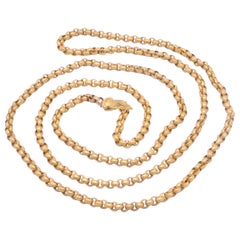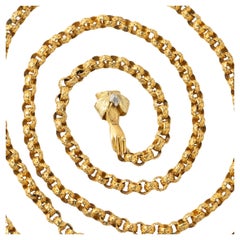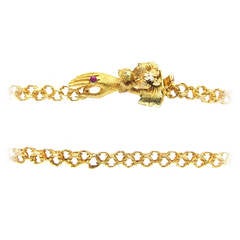Georgian Chain Hand Clasp
Antique Early 1800s British Georgian Chain Necklaces
Pinchbeck
Antique Late 18th Century European Georgian Chain Necklaces
18k Gold, Yellow Gold
Recent Sales
Antique Early 18th Century English Georgian More Jewelry
Ruby, 18k Gold
Antique 1750s Georgian Chain Necklaces
Diamond, 10k Gold
Antique 1830s Georgian Chain Necklaces
Emerald, Ruby, Gold, 18k Gold
British Chain Necklaces
Antique 1830s British Georgian Chain Necklaces
Pinchbeck
Antique Early 19th Century British Georgian Chain Necklaces
Emerald, 18k Gold
Antique Late 19th Century British Victorian Chain Necklaces
Pinchbeck
Antique Early 19th Century British Georgian Chain Necklaces
Turquoise, 15k Gold
People Also Browsed
Antique 1890s English Victorian Cocktail Rings
Diamond, Moonstone, 9k Gold, Silver
21st Century and Contemporary Swiss Wrist Watches
Yellow Gold
2010s Italian Contemporary Chain Necklaces
18k Gold, White Gold, Yellow Gold
Antique Late 19th Century British Victorian Brooches
Diamond, Natural Pearl, Ruby, Yellow Gold
2010s American Evening Dresses
Antique 1750s Unknown Georgian More Necklaces
Topaz, 18k Gold
Early 2000s European Aesthetic Evening Dresses
20th Century Unknown Egyptian Revival Link Bracelets
Gold, 18k Gold, Yellow Gold
21st Century and Contemporary Swiss Wrist Watches
Gold, 18k Gold, Yellow Gold
21st Century and Contemporary French Wrist Watches
18k Gold, Rose Gold, Platinum
Early 2000s Italian Evening Gowns
1990s English Evening Dresses and Gowns
Antique 18th Century Georgian Engagement Rings
Diamond, 14k Gold
Antique Early 19th Century British Georgian More Jewelry
Cut Steel
Early 2000s Italian Evening Gowns
Antique Early 19th Century British Georgian Signet Rings
Carnelian, Yellow Gold, Gold
Georgian Chain Hand Clasp For Sale on 1stDibs
How Much is a Georgian Chain Hand Clasp?
A Close Look at Georgian Jewelry
Georgian jewelry is named for the monarchies of the four King Georges, who in succession ruled England starting in 1714 (plus King William’s reign, which lasted until 1837). A slew of beautiful pieces were produced during the period, and today antique Georgian rings, necklaces and other accessories are coveted by fine jewelry collectors.
There are certain features that distinguish jewelry from this era, including the fact that pieces from the 18th and early 19th centuries were handmade (so don’t let the absence of a maker’s mark lead you to believe otherwise). Antique Georgian jewelry also has a certain “look.” It’s a bit gray because stones were often set in silver, and because stonecutting techniques were not as advanced as they are today, the gems do not possess the level of sparkle to which we have become accustomed.
Intricate metalworking techniques such as repoussé (the hammering of metal into ornate designs) and cannetille (a method of working the gold wire to make it look woven) allowed goldsmiths to really flex their muscles. These gold pieces, either on their own or combined with gemstones, made for highly original and dramatic jewelry. The era also saw pieces with ornately woven strands of human hair.
Pearls, along with colored gemstones like garnets, rubies and sapphires, were widely used in Georgian jewelry. These were often cut in the shape of a cabochon or teardrop. It was fashionable to combine garnets or rubies with seed pearls. In Georgian diamond rings, popular cuts for diamonds included rose, old mine and table. Around the 1780s, paste jewelry, or hand-cut glass on foil, was used to imitate diamonds.
Browse a collection of antique Georgian diamond rings, earrings, brooches and other authentic Georgian jewelry today on 1stDibs.
Finding the Right Chain-necklaces for You
Vintage chain necklaces can make a statement on their own. What’s better than eye-catching chains of yellow gold or subtle silver to accessorize with everything from a designer evening dress to a comfortable sweatshirt?
Personal ornament in general has been around for eons. Ancient Egyptians designed jewelry and wore necklaces, rings and other accessories, and the excavation of King Tut’s burial chamber in 1922 had the greatest impact on Art Deco jewelry. When chain necklaces first took on some visibility in ancient civilizations, these items weren’t exactly democratic.
Chain necklaces were accessories that were relegated strictly to royal families and the upper class. In ancient times, pendant necklaces conferred prestige, for example. Wealthy Greeks and Romans opted for gold and silver necklaces that featured ornate pendants and semiprecious stones. By the Renaissance period, the pendant had replaced the brooch as the most worn type of jewelry. Pendant necklaces were commonplace, or pendants were simply strung on long gold chains.
Thankfully, jewelry became more accessible over time. And trends have come and gone, but the popularity of chain necklaces today owes in part to hip-hop culture. Big, chunky gold chains and diamond necklaces were the order of the day in publicity shoots and on album covers for rappers in the early 1980s onward, and a gold chain is still a mainstay in the ever-evolving and broadening hip-hop culture as we know it.
In our modern era, a number of chain-link necklaces are trending, worn alone or layered. The stylish links that have passed the test of time include oval links, paper-clip chains and more. The best way to discover your perfect fit is to zero in on a particular name and type of link.
While it was once key to accessorizing for a formal event, a vintage chain necklace now adds a fresh dynamic to any outfit at any time of day. Find yours on 1stDibs.



